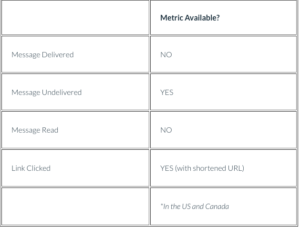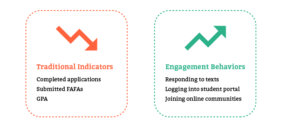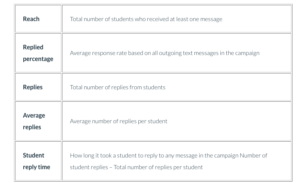By: Greg Bauch, Copywriter at Mongoose Research
Engagement and behavior can tell you if your texting campaigns are working.
One of the things that makes email marketing popular is the ability to rate the performance of communication with metrics. And, while you don’t receive open and click rates for texts sent, there are clear ways to track which ones are connecting with students.

Currently, in North America, we do not have access to the delivery status of a text, even though other parts of the world have this capability. However, we believe it’s accurate to assume that 99% of text messages are read, primarily because, unlike email, there isn’t an abundance of spam that people are trained to ignore. (Another reason every text you send needs to be relevant and valuable.)
The Era of Digital Engagement
Behavior-based indicators have, for the most part, replaced traditional methods for measuring success in higher education. Results speak louder than open rates. For enrollment, retention, and student success, the key is to invite students to take action and track desired behaviors.

Texting is an ideal medium to nudge students to take action and align them with appropriate resources. It’s instant, efficient, student-preferred, and highly measurable.
5 Important Metrics That Rate Success
In the reporting feature of our texting platform (Cadence), our partner institutions can quickly view campaign metrics demonstrating engagement and behavior.

So, how do you use these insights to measure outcomes? One of our clients, a four-year private institution, found that 76% of students who confirmed their enrollment had engaged through texting by replying at least once. And 40% responded three times or more.

Another client, in Adult & Online Education, engaged all of their students with text messaging and saw adds and drops decrease from 21% to 9%, as well as a 5% increase in retention.
These results make it clear that, in the end, metrics like the number of messages sent, delivery rate, and open rate (even if we could know those last two numbers) can’t compare to student engagement and improved outcomes.
The takeaway: The more engagement you’re creating – the better.
*Special thanks to Greg Bauch, Copywriter at Mongoose Research—a company that publishes content including industry insights, webinars, case studies, and best practices focused on one goal: helping colleges and universities continuously improve the ways they communicate with students—for guest-writing this blog post. Mongoose is a Platinum sponsor of the 2019 TargetX Summit.
